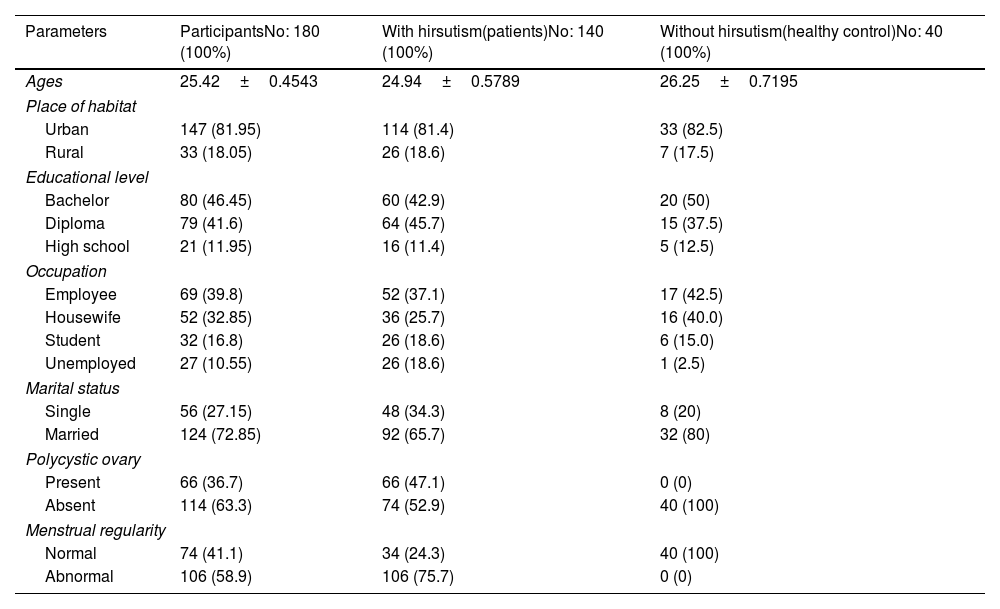Polycystic ovary syndrome (PCOS) is the most common endocrinopathy affecting approximately 5–10% of women of reproductive age and it is also a major cause of anovulatory infertility. PCOS is associated with obesity and conditions like hirsutism, acne, diabetes, and irregular periods.
AimThe present study aimed to evaluate the serum-free testosterone (FT) levels of women afflicted with hirsutism, one of the main physical manifestations of PCOS versus healthy women and determine whether their serum testosterone levels correlate with polycystic ovaries, glucose levels, menstrual abnormalities, and obesity.
MethodsThis study assessed 180 women; this included 140 females who suffered from excessive and unwanted hair growth on the chin and 40 healthy women as a control group. Free testosterone levels and fasting blood glucose levels were taken. Prior to the study, ultrasonographic (US) tests were performed for all patients to diagnose polycystic ovaries.
ResultsPatients with hirsutism exhibited a significant elevation in free testosterone (FT) compared to the control group. Approximately half of these women were confirmed to have a polycystic ovary, and 42.8% of them were overweight and obese. Additionally, women between 18 and 20 years old (G1) present with the highest level of FT.
ConclusionSerum FT levels were significantly increased in hirsute women, and this positively correlated with BMI and glucose levels in women with PCOS. Glucose levels may serve as a potentially effective biomarker in evaluating the severity of hirsutism in women suspected of having PCOS.
El síndrome de ovario poliquístico (SOP) es la endocrinopatía más común que afecta aproximadamente al 5-10% de las mujeres en edad reproductiva y también es una de las principales causas de infertilidad anovulatoria. El SOP está asociado con la obesidad y condiciones como hirsutismo, acné, diabetes y períodos irregulares.
ObjetivoEl presente estudio tuvo como objetivo evaluar los niveles séricos de testosterona libre (FT, del inglés) de mujeres con hirsutismo, una de las principales manifestaciones físicas del síndrome de ovario poliquístico, en comparación con mujeres sanas y determinar si los niveles séricos de testosterona se correlacionan con ovarios poliquísticos, niveles de glucosa, anomalías menstruales y obesidad.
MétodosEste estudio evaluó a 180 mujeres; esto incluyó a 140 mujeres que sufrían de un crecimiento de vello excesivo e indeseado en la barbilla y 40 mujeres sanas como grupo de control. Se midieron el nivel de FT y el nivel de azúcar en sangre en ayunas. Antes del estudio, se realizaron pruebas ultrasonográficas a todas las pacientes para diagnosticar ovarios poliquísticos.
ResultadosLos pacientes con hirsutismo exhibieron una elevación significativa en la FT en comparación con el grupo de control. Se confirmó que aproximadamente la mitad de estas mujeres tenían un ovario poliquístico y el 42,8% de ellas tenían sobrepeso y obesidad. Adicionalmente, las mujeres entre 18 y 20 años (G1) presentan el mayor nivel de FT.
ConclusiónLos niveles séricos de FT aumentaron significativamente en mujeres hirsutas, y esto se correlacionó positivamente con el IMC y los niveles de glucosa en mujeres con SOP. Los niveles de glucosa pueden servir como un biomarcador potencialmente eficaz para evaluar la gravedad del hirsutismo en mujeres con sospecha de SOP.












